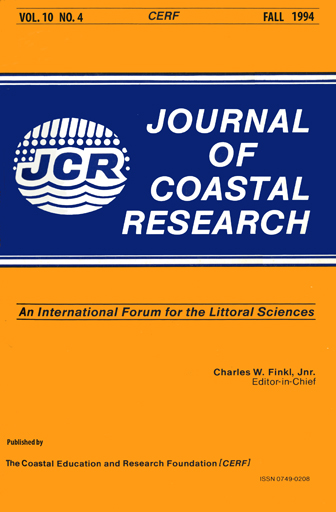Stages and Durations of Post-Storm Beach Recovery, Southeastern Texas Coast, U.S.A.
Keywords:
Coastal processes, beach profiles, shoreline changes, nearshore sand transport, storm impactsAbstract
Severely eroded beaches of the southeastern Texas coast monitored for ten years following a category 3 hurricane reveal four time-dependent stages of recovery. The dominant processes during the four stages of recovery are as follow: (1) rapid forebeach accretion, (2) backbeach aggradation, (3) dune formation, and (4) dune expansion and vegetation recolonization. Only undeveloped beaches experienced all four stages of post-storm recovery. Developed beaches reached stage 2, but additional recovery was prevented because beach widths seaward of the houses were too narrow to permit eolian transport and construction of dunes.
Post-storm recovery lasted four to five years before the beaches of Galveston Island began responding to local events that dictated subsequent changes in beach volume. Only two of seven profile sites experienced complete recovery in terms of sand volume gained, compared to the volume lost during the storm. Partial recovery at the other sites ranged from 7% to 71% of the volume eroded during the storm. After the four- to five-year period of partial recovery, several beach segments entered an erosional phase that reflects the long-term trend of beach behavior.
Post-storm beach responses at individual sites were highly variable and included the following; (1) erosion and continuous loss of beach volume, (2) partial recovery and subsequent erosion, (3) complete recovery, and (4) continuous gains in beach volume that greatly exceed the volume eroded by the storm. Some of the factors that locally controlled beach response were interactions with shoals at an adjacent tidal inlet, the adverse effects of updrift coastal structures, and along-shore migration of shoreline rhythms that alter sand supply.
The maximum cumulative recovery of sand occurred four years after the storm when approximately 67% of the eroded sand could be accounted for, as storm washover terraces deposited on the barrier flat (12%) or as beach and dune sand returned during the recovery phase (55%). Apparently the remaining volume of sand eroded from, but not returned to the beach, was transported downdrift and stored on the shoreface where it has contributed to spit accretion on Galveston Island.


